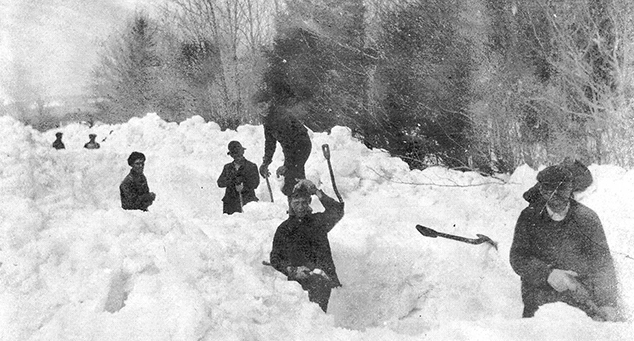
This photo of the massive amount of effort involved in removing snow after a large snowstorm is believed to have been taken on Sam Hill Road, formerly known as Cilley Hill Road. Photo: copied from Robie Family photo album
When I came across these pictures, I was reminded of Andover’s recent Town Meeting with its recurring discussion of road agents, a Town garage, and Town-owned equipment. As a result, I thought it would be interesting to take a quick look at how Andover’s early road system developed, how the roads were maintained, and who maintained them.
Both John Eastman and Ralph Chaffee, in their history of Andover books, discuss this subject, and I will briefly touch upon some of their writings. Following this, I will take a look at the people in the pictures — people who were working to maintain Andover’s roads during their time in the early 1900s.

According to John Eastman’s, History of Andover New Hampshire, 1751 to 1906, the proprietors of what would eventually become the township of Andover realized that passable roads were necessary in order to stimulate settlement. Many of their meetings dealt with this subject, as committees were set up to lay out roads and surveyors and workers were hired and paid by the proprietors to cut and clear the land.
After Andover’s incorporation in 1779, money from a highway tax was placed in the hands of surveyors to be used on the roads in their respective districts, and by 1790 there were eight districts. Eastman also mentions that each taxpayer could work out his highway tax in his own district at a fixed rate per hour.
During the 1800s, Andover’s road system continued to grow, as more and more settlers arrived. Surveyors were still in charge, and they hired workers to help as needed and as the allotted money allowed.
For the most part, work was done by hand with the help of horses and oxen. But in 1885 the Town purchased a horse-drawn iron road machine, or grader, which was a big help in shaping the road surfaces and carrying out ditching. The use of snow roller machines around this same time provided much better roads for winter traveling.
Ralph Chaffee, in his History of Andover, 1900 to 1960, notes that in 1892, Andover abandoned the old system of district highway surveyors in favor of the so-called “town” or two road agent arrangement. Instead of a dozen or more men, with each being allotted a small amount of money to maintain a few miles of road as he saw fit, the responsibility for the care of the highways could now be placed in the hands of one person at each end of the town. Thus the labor and equipment could be used more efficiently and the available money spent where it was needed most. This system remained in use until 1953, when it was changed to a single road agent for the whole town.
Chaffee also mentions that the arrival of the automobile created many problems for Andover’s roads, which were not built and maintained for this type of travel. But eventually the automobile also provided some solutions.
Beginning around 1920, dump trucks made it possible to haul better gravel a greater distance, more of it, and faster. In 1927 the Town purchased its first snow removal unit, a Mead-Morrison crawler tractor with a Snow King rotary plow, thus ending the days of the snow rollers. In 1929 the Town bought a four-wheel-drive truck and snowplow, and thus began the move to modernize and mechanize Andover’s highway system.
Early Andover Pictures
The summer picture is from a real-photo postcard that was my mother’s. I believe the third man from the left is Guy Hersey, her father. Guy grew up on Chase Hill Road, which may be where this picture was taken, although it looks more like nearby Emery Road. Note the car just below the work crew, along with its driver, and the man wearing a dress suit in the picture.
These men, along with the photographer, may have been connected with the Halcyon Hills Farm on Emery Road which was owned for a number of years by Willam A. Richardson. (If anyone has a similar picture, or has more information on the people, or where the photo was taken, I would love to hear from them!)
The winter picture, I believe was taken on Cilley Hill Road (Sam Hill Road today), and the man on the left in the front may be Robert Robie, my great uncle. Robert moved here with his parents and sisters in 1895, and he later took over the family farm. (A part of the house can be seen in the photo.) This picture was copied from a Robie photo album.
This area, even today, is noted for its blowing and drifting snow! (Again, if anyone has more information about this picture or the people in it, please let me know.)
Early Andover town reports list the names of workers who were paid for labor on the highways. As just one example, the 1905 report says that from December, January, to February 15, Robert Robie was paid $45.43 and Guy Hersey was paid $10.50.
Speaking of early town reports, they can make for some very interesting reading! If anyone has ancestors who lived in Andover, their names can most likely be found in the town report. Every bit of money that was paid out of the treasury lists the name of the person it went to, what it was for, and how much.
Teachers’ names are listed and what they were paid. The school children were named, what term they attended, who was on the honor roll, and who had perfect attendance. So if you need a change of pace in your reading material during this stay-at-home time, pick up an old town report!